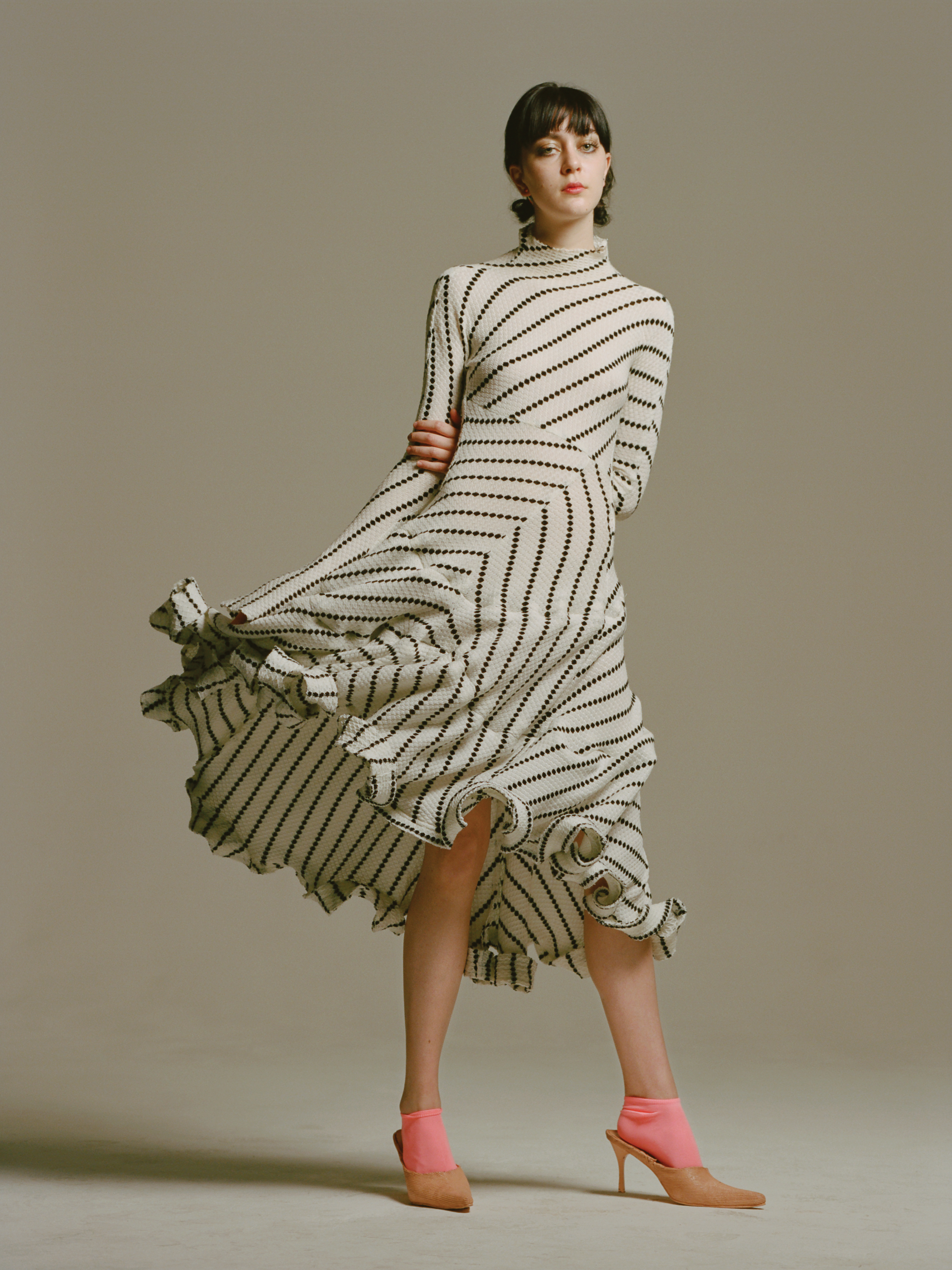Office —What was growing up in Ireland like? Can you tell me about your town?
Richard Malone — It’s beautiful. It’s really, really rural. It’s nice, because it’s totally quiet. It’s one of those seaside sand towns. There’s a lot of them in Britain as well—they look amazing to tourists, but the reality is that living there can be quite different. There are a lot of drug problems and a lot of crime. It’s a different thing to live there because it’s quite a secluded, periphery town. Coming to London I was very aware that where I was from was very different from the background of a lot of people.
O — Was it a hard transition to move from such a rural upbringing? I can’t imagine there was much fashion growing up.
RM — God, no. My dad is a painter and decorator, he paints houses. My mom had a shop job. I was never really exposed to any kind of creative careers. When I was younger, I would always work on building sites, from when I was about thirteen to when I left at about eighteen. My approach to materials is different to what other people are used to doing. I think it’s actually a good thing that I never knew much about fashion. When I first applied to Central Saint Martins, I didn’t really know what it was. I was only the second person in my whole family to go to university, it was such an opportunity to go to a school like that. It was quite hard, when I got to Saint Martins, you realize that—even more so now that the fees have gone up—it’s quite a homogenized group of people. I feel like there are a lot of very white, very rich, Notting Hill, West End people. I think to the tutors it was very refreshing to have someone like me because I didn’t care about fashion particularly, it was just what I was doing and the way that I was working. I did a lot of projects that were a lot more performance-based. For one project, I didn’t make any clothes, I just sort of wrote a story. For others, I did video work. There was something quite different about the way that I worked, they responded quite well to that. I guess I was lucky in a way.
O — Is your upbringing within the working class in the Irish countryside implemented into your work? There’s this idea of uniform dressing and traditional workwear that you’re often exposed to in the suburbs.
RM — That’s what you’re sort of surrounded by. In a town like that, people don’t dress for vanity at all. My mom would have a uniform for the shop she worked in and my dad would have a uniform for work. I had a horrible Catholic school uniform. You’d find ways of rebelling through a uniform, like wearing different shoes. I think it’s very interesting how people who have shit to do dress. It’s a far more interesting way of dressing—you dress for warmth, you dress for work. You don’t really consider a “look.” Whereas when I got to Saint Martins, I was really surprised at how many people spent a lot of time getting ready. Even now when I do research, I do a lot of photography and real drawing out on the street. I just look at what people are wearing and their ways of mixing silhouettes. They don’t care about something being fitted perfectly. It’s always a quite interesting place to start, because it’s directly related to people.
O — I always find it interesting to study people on public transportation, for example, and draw observations of mass trends based on that.
RM — I find there’s a lot less originality in major cities, it’s sometimes just the “cool thing,” that I despise. It almost kind of whitewashes everyone. I find it really interesting that these trends in infiltrate young people so much more immediately now than they used to. I’ve got young cousins and the whole Instagram, Facebook thing just kind of freaks me out. They’re so in tune with it and it’s such a part of their life. They engage with it every single day. That influences the way that they dress and the way they try to appear to other people. I don’t know if I’m comfortable with it entirely. At the moment, I’m thinking about how I can get away with non-Instagrammable things. I’m onto something at the minute here that I think is going to work. There are some fabrics that look completely different in a photo than they do in real life. The fabric from last season didn’t translate at all in photos, which I loved.
O — Has your stance been to try and develop a way to fight the social media system? There’s so much pressure to create ephemeral “moments.”
RM — We made this really amazing set with this gorgeous sculpture installation with all the models. I didn’t want anyone to take photos. For me, it took away from the whole experience, wandering around this Soho restaurant that we cleared out, this bourgeois furnishing with weird gold that was really worn-in. All the Style.com and Vogue Runway images, it doesn’t have the same translation. You don’t see the clothes at all, you just see a front-on image. Especially for me, I wouldn’t say that I really design for a front view. I kind of design quite 3D things. I don’t think they’ll ever translate in photos. I don’t really want them to translate in simple photos like that, because I kind of hate them. It’s not something that interests me. It’s just this pace of fashion. I’m almost trying to avoid it as much as I can and as much as people will let me. I can’t not let people take photos at Fashion Week—although I did the first time.
